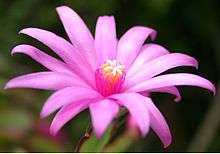Hatiora gaertneri
| Hatiora gaertneri | |
|---|---|
 | |
| In cultivation | |
| Scientific classification | |
| Kingdom: | Plantae |
| (unranked): | Angiosperms |
| (unranked): | Eudicots |
| (unranked): | Core eudicots |
| Order: | Caryophyllales |
| Family: | Cactaceae |
| Subfamily: | Cactoideae |
| Tribe: | Rhipsalideae |
| Genus: | Hatiora |
| Species: | H. gaertneri |
| Binomial name | |
| Hatiora gaertneri (Regel) Barthlott[1] | |
| Synonyms[1] | |
| |
Hatiora gaertneri is a species of epiphytic cactus which belongs to the tribe Rhipsalideae within the subfamily Cactoideae of the Cactaceae. Together with the hybrid with H. rosea, Hatiora ×graeseri, it is known as Easter cactus or Whitsun cactus and is a widely cultivated ornamental plant.
Description
H. gaertneri is found in southeastern Brazil, in Paraná and Santa Catarina, at altitudes of 350–1,300 m (1,100–4,300 ft). As with other species of the genus, H. gaertneri grows on trees (epiphytic) or less often rocks (lithophytic) in sub-tropical rain forest. With maturity, it develops into a branching pendant leafless shrub with a woody base. The stems are made up of segments, most of which are flattened and which are the photosynthetic organs (cladodes) of the plant. Younger segments are dullish green, 4–7 cm (1.6–2.8 in) long and 2–2.5 cm (0.8–1.0 in) wide, with small notches on the margins. Structures characteristic of cacti, called areoles, form in these notches. Flowers form from areoles at the ends of the stems. These are scarlet in colour, 4–5 cm (1.6–2.0 in) long, radially symmetrical (actinomorphic), opening to a funnel shape with a maximum diameter of about 4–7.5 cm (1.6–3.0 in). Red oblong fruits form after the flowers are fertilized.[1]
Taxonomy
Although cacti belonging to the tribe Rhipsalideae are quite distinct in appearance and habit from other cacti, as they grow on trees or rocks as epiphytes or lithophytes, for a long time there was confusion as to how the species should be placed into genera. Hatiora gaertneri was first described in 1884 by Eduard von Regel as the variety gaertneri of Epiphyllum russellianum (now Schlumbergera russelliana). The name honours Joseph Gaertner. In 1889 William Watson elevated it to the full species E. gaertneri and in 1913, Nathaniel Britton and Josephy Rose transferred it to Schlumbergera as S. gaertneri.[1]
The relationship to S. russelliana was based on the appearance of the stems, made up of flattened segments with small teeth, and the radially symmetrical shape of the flowers. However, the deeper structure of the flower differs considerably from Schlumbergera, which has a short floral tube at the base of the flower formed by fused petals, and stamens arranged in two distinct series, whereas H. gaertneri has separate petals and a single series of stamens. H. gaertneri was separated from Schlumbergera as Rhipsalis gaertneri by Friedrich Vaupel in 1925, after which it was successively transferred to Epiphyllopsis by Alwin Berger in 1929, Rhipsalidopsis by Reid Moran in 1953, and finally Hatiora by Wilhelm Barthlott in 1987.[1]
According to Anderson,[1] the confusion among the Rhipsalideae was not clarified until work by Barthlott and Nigel Taylor in 1995.[2] In horticultural sources, the Easter cactus is still referred to as Schlumbergera gaertneri,[3] as well as Rhipsalidopsis gaertneri.[4]
Cultivation

Under the name Easter cactus or Whitsun cactus, Hatiora gaertneri is widely cultivated as an ornamental plant for its scarlet flowers. Its common names reflect the period in which it flowers in the Northern Hemisphere, namely late Spring. It has been artificially crossed with a pink-flowered species, Hatiora rosea, to form the hybrid H. ×graeseri, cultivars of which have flowers in a wider range of colours.
The Easter cactus is considered more difficult to grow than the Christmas or Thanksgiving cactus (Schlumbergera).[4] Recommendations for care include:
- Temperature Summer temperatures around 25 °C (77 °F) are suggested,[3] with lower temperatures down to 7–13 °C (45–55 °F) in the winter (November to January in the Northern Hemisphere) to initiate good bud formation.[4]
- Light As epiphytic forest plants, they are not exposed to strong sunlight. Half-shade is recommended; plants can be placed outside in the summer.[5]
- Watering The Easter cactus is said to respond badly to over- or under-watering, e.g. by losing stem segments; continuously moist soil is recommended.[4]
- Propagation Stem segments may be removed in late Spring and the cut surface allowed to dry out before being placed in slightly moist soil.[5]
References
- 1 2 3 4 5 6 Anderson 2001, pp. 375–376
- ↑ Barthlott, W. & Taylor, N.P. (1995), "Notes towards a monograph of Rhipsalidaeae (Cactaceae)", Bradleya, 13: 43–79, cited in Anderson 2001, p. 375
- 1 2 Schlumbergera gaertneri – Easter cactus, indoor-plant-care.com, archived from the original on 2011-12-01, retrieved 2011-12-01 External link in
|publisher=(help) - 1 2 3 4 Brunelle, Paul J. (2001), Recognition and Culture of the Holiday Cacti, Dalhousie University, archived from the original on 2011-11-04, retrieved 2011-11-04
- 1 2 Hecht, Hans (1997), Cacti and Succulents, trans. A. Englander (p/b ed.), New York: Sterling, ISBN 978-0-8069-0549-5, p. 74
Bibliography
| Wikimedia Commons has media related to Hatiora gaertneri. |
- Anderson, Edward F. (2001), The Cactus Family, Pentland, Oregon: Timber Press, ISBN 978-0-88192-498-5